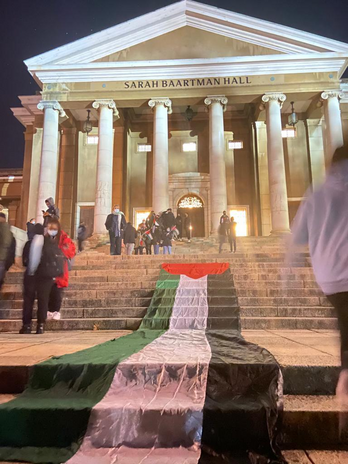Overview
The world breathed a collective sigh of relief as a cease-fire went into force between Israel and the Hamas on Friday morning, following more than 10 days of violence that terrorized Gaza City. The violence that claimed hundreds of lives has been described as the deadliest Israeli-Palestinian fight in seven years and prompted a rapidly escalating humanitarian crisis, as the death toll began including dozens of Palestinian children.
Though cease-fire brings a fragile peace, underlying conflict remains: the dispute over rights to land in Jerusalem and the West Bank and old religious tensions in the Old City of Jerusalem, in which Gaza gets caught in the crossfire. This conflict is not during its’ infancy, and is one of the world’s most enduring conflicts, spanning a total of 53 years. This article will delve deeply into the history of the Israeli-Palestinian conflict before bringing us to where we are today.
Palestine and its Significance
Palestine is a small region of land marked by its importance to several major religions and by its geographical uniqueness; it sits at crossroads with Africa and Asia. As such, it has been the site of longstanding political conflict and violent land seizures, dating back to ancient times. Theoretically, the Palestine region includes the West Bank – a territory that sits between modern-day Israel and Jordan – and the Gaza strip – which borders modern-day Israel and Egypt.
Lack of international consensus concerning the borders further fuels an already complex and evolving situation, and as recent events would prove, the fight for control is not a smooth one. Many areas claimed by Palestinians have been occupied by Israeli people for years, and though more than 135 United Nations member countries consider and recognize Palestine as an independent state, Israel and other countries do not.
The Partition of Palestine
After World War 1 ended, the British took over Palestine and the League of Nations issued a British mandate which ensured British administrative control over the region and established a Jewish homeland in Palestine. The mandate went into effect in 1923. After two decades of British rule, the United Nations proposed a partition of Palestine into an independent Jewish state and an independent Arab state. Jerusalem was claimed by both Jews and Palestinian Arabs as their capital.
The partition was accepted was accepted by Jewish leaders, but many Palestinian Arabs vehemently opposed it, and argued that they represented the majority of the population in certain regions and should therefore be granted more territory. Consequently, they began forming volunteer armies throughout Palestine.
British Withdrawal: Israeli State
Less than a year after introducing the partition, British rule withdrew from Palestine and Israel declared itself an independent state. Neighbouring Arab armies moved in to prevent the establishment of the Israeli state. Following a war in 1948 that involved Israel and five Arab nations – Jordan, Iraq, Syria, Egypt, and Lebanon – Israel took control of more than two thirds of the former British Mandate, while Jordan took control of the West Bank, Egypt, and the Gaza strip. The 1948 war birthed a new chapter in the struggle between the Jews and the Palestinian Arabs, marked by an entanglement of nation-states and diplomatic, political, and economic interests.
The Palestine Liberation Organization was formed in 1964 with the aim of establishing a Palestinian Arab state on the land that was previously under British mandate and occupied by the State of Israel. Although the original intent was the dissolvement of the Israeli state as a means to attain Palestine statehood, in the Oslo Accords, the PLO accepted Israel’s right to exist in exchange for formal recognition of the PLO by the Israeli state.
It is considered a high-water mark in Israeli-Palestinian relations.
The Six Day War: Further Israeli Gains
The Six Day War erupted during a hostile period of diplomatic friction between Israel and neighbouring states. In April 1967, these frictions took a turn for the worse after Israel and Syria engaged in devastating air and artillery strikes, in which six Syrian fighter jets were destroyed.
Following the air strikes, the Soviet Union provided Egypt with knowledge that Israel was moving troops to its Northern border with Syria in preparation for a multi-pronged invasion. Though the information was inaccurate, Egyptian President Nasser sent forces into Sinai Peninsula, where a United Nations peacekeeping force was expelled.
Israeli Defence Forces responded by launching an aerial attack against Egypt in June the same year. By the end of the war, Israel had taken control of the Gaza strip, the West Bank, the Sinai Peninsula, and the Golan Heights. The outcome of the Six Day War would plague Israel and its neighbours for generations to come.
Resistance: The Intifadas and the Oslo Accords
In 1987, precisely two decades later, the First Intifada broke out, an explosion of Palestinian anger over ongoing Israeli occupation of the Gaza strip and the West Bank. Palestinian militia groups revolted, and hundreds of people were killed. The Oslo Accords was initiated, a multifaceted peace process to end the ongoing violence.
The first Oslo Accord created a timetable for a Middle East peace process and provisions for an interim Palestinian government in parts of Gaza and the West Bank. The second Oslo Accord accounted for the complete withdrawal of Israeli troops occupation from parts of the West Bank and others. Unfortunately, the Oslo Accords would never reach fruition and failed to bring a fully-fledged peace plan to the forefront.
In September 2000, the Second Intifada broke out. One of the many triggers was when Ariel Sharon, a right-wing Jewish Israeli visited the Muslim holy site al-Aqsa Mosque in Jerusalem, an act many Palestinians viewed as offensive.
Riots, suicide bombings and other attacks broke out, squashing any remnants of a peace process. This violent conflict between Israel and Palestinians lasted almost five years. By August 2005, the Israeli Army withdrew from Gaza.
The Hamas and the 2014 Agreement
The Hamas – a Sunni Islamist militant group – won the Palestinian legislative elections in 2006. That same year, fighting ensued between the Hamas and the Fatah – the political group operating the PLO, in which the Hamas defeated the Fatah in a battle for Gaza. The Hamas and Israel fought each other in several bloody wars in the years to come that ultimately resulted in them agreeing to form a unified national Palestinian government in 2014.
However, Palestinians continue in the struggle for an independent nation state.
The Current Conflict: How it started, and What Happened
The conflict started on the 10th of May, after weeks of bubbling tensions in Jerusalem among Palestinian protestors, the police, and right-wing Israelis rapidly escalated. This tension rests upon a deep history of the longstanding, bloodied struggle for control of a city sacred to many religious groups.
The circumstances which led to the latest violence is plentiful and many events can be described as what set off a bomb that has been ticking for decades. Protests had gone on for days preceding the attacks, centred around an intense dispute over East Jerusalem, which is predominantly Palestinian. A Supreme Court ruling was expected on May 10th on the eviction of several Palestinian families from East Jerusalem, but it was postponed. Israeli officials watered down the dispute to that of real estate affairs, however many Arabs called it unlawful, and part of a wider Israeli campaign to force Palestinians out of the city. This can be described as ethnic cleansing.
Protests dramatically increased and intensified after Israeli police prevented Palestinians from practicing religious traditions by denying them from gathering near one of the Old City of Gaza’s ancient gates, a custom during the holy month of Ramadan. The police responded on May 7th by raiding the Aqsa Mosque compound, one of Islam’s holiest and most precious sites, allegedly to keep Palestinian protestors from throwing stones.
The sight of stun grenades and bullets raining down on one of the holiest sites in Islam on the last Friday of Ramadan was an insult of catastrophic proportions. Hundreds of Palestinians were wounded, as well as a score of police officers.
The outbreak of war was not expected, but on May 10th, rocket fire in Gaza began. Israeli warplanes started bombarding Gaza, and at the same time, the Hamas began the rocket barrage. As the civilian death toll staggeringly grew, the conflict galvanized the Israeli society and spurred unrest with renewed vigour.
The Current Conflict: Who was killed?
Israeli airstrikes and artillery barrages on Gaza killed at least 230 people, including 65 children and wounded 1620 as of Thursday, creating an image that the world will have a hard time forgetting. On the opposite end, Hamas missiles rained above Israeli towns and cities, inciting fear, and panic, killing at least 12 Israeli residents, including two children.
Israeli officials, strategists and representatives emphasized the ultimate goal: the evaporation of as much as possible Hamas structure, including the network of rocket factories and underground tunnels. However, Israel came under intense and increasing international criticism and pressure for the growing number of deaths amongst children in the airstrikes on Gaza. Among these deaths were eight children killed in a single airstrike.
Gaza: Humanitarian Crisis
Gaza was already suffering under the weight of an indefinite blockade by Israel and Egypt, as well as decades of bloodied conflict, even before the latest conflict. But the battle between the Israeli military and the Hamas militants prompted a never-seen-before devastating humanitarian crisis.
The fighting has damaged or destroyed 17 hospitals and clinics in Gaza, amongst which was its only coronavirus testing facility. It sent fetid wastewater into the streets and has broken water pipes that serve at least 800 000 residents. Sewage systems have been destroyed, and a desalination plant that helped provide fresh water to nearly 250 000 people is offline.
Dozens of schools have been damaged and consequently closed, effectively causing 600 000 students to miss out on their education. It is estimated that roughly 72 000 Gazans fled their homes. Aside from these consequences, many civilians have suffered intense psychological warfare and scarring. Many lost their loved ones and have been severely displaced from their homes.
Israel, the Hamas, and other militant groups in Gaza were called on by international parties to cease-fire, which took place Friday morning. Though both parties are still wary of how it will play out, there is a shared sense of relief felt around the world.
Conclusion: What You Can Do To Help
Many charities have come forward with appeals to help the victims of the conflict with emergency medical treatment, food, and shelter. Below is a link to 11 charities which you can donate to, if you are able to, to help Palestine.
Being silent is a complacency Palestine cannot afford. This is a humanitarian crisis, in which there are no neutralities. Remember, you can be pro-Palestine without being anti-Semitic. From the river to the sea, Palestine will be free.
Glossary
Partition – divide into parts
Intifada – a rebellion or uprising
Oslo Accords – a pair of agreements between the Government of Israel and the Palestinian Liberation Organization


